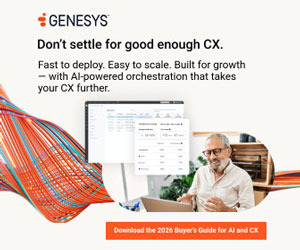Ginger Conlon at Genesys explains that it’s time to emphasis real-time CX metrics
Nine out of 10 business leaders say being able to better measure customer experience (CX) would make it easier to drive growth.
But 40% say one of their greatest measurement challenges is translating those metrics into actionable insights, according to the report “Beyond Net Promoter Score: Rethinking CX Metrics,” by Harvard Business Review Analytic Services, in collaboration with Genesys.
Even so, almost half of those surveyed say they’ll significantly increase their investments in measuring CX. Why? According to 82% of CX leaders polled, understanding the quality of the customer experience at key milestones is important to their business strategy.
Measuring CX lets companies optimize the customer journey, identify opportunities for product improvements or innovation, and drive better business outcomes. They can also better understand customer preferences and identify the root causes of customer frustration, among other benefits.
Many companies, however, find it difficult to measure CX in a way that helps them improve customer and employee engagement, as well as business outcomes. Customer satisfaction, Net Promoter Score (NPS) and similar metrics are important.
But if they don’t get to the “Why” behind those behaviors, it can lead to frustration and blind spots — a signal to customers you’re not truly paying attention. And without the why, these metrics exclude valuable data your employees could use to deliver the empathetic experiences your customers expect.
Just 28% of surveyed executives said their organization has a very good understanding of customer satisfaction across all phases of the customer journey, according to the HBR report. And about 41% of executives say they can’t explain why CX metrics go up or down.
Developing new approaches to journey measurement is a priority for businesses that want to drive agile decision-making and real-time action. Journey measurement, for example, can provide insights that allow companies to optimize the customer journey in real time. That improves the experience and increases the likelihood of conversions and purchases.
It also can reduce customer frustration. If customers do need to escalate from online to an agent, it’s likely to be a better experience for everyone.
What CX Leaders Do Differently
“CX leaders” in companies that participated in the HBR study are more likely than others to measure CX with predictive analytics and sentiment analysis. They’re also more likely to share that data with a wide internal audience.
This gives employees knowledge into how they’re performing. And senior leadership has buy-in to act on measurement insights.
Correlating CX metrics with business outcomes is another area where these leaders are significantly more effective than those considered “laggards.” CX leaders gain a deeper understanding of customer preferences, improve their journeys, and use metrics in strategy and planning.
A notable shift in rethinking CX measurement is how and when companies use these insights. Lagging indicators drawn from satisfaction and NPS surveys still have a place. But the focus on measurement should come earlier and throughout the journey.
Predictive engagement, for example, senses a customer’s intent and directs them to the right content or employee. This makes the customer feel heard and understood.
This is especially important because 83% of consumers say being listened to and understood are the most important aspects of a customer service interaction.
Other advances include real-time sentiment analysis, which allows employees to course-correct during customer interactions.
Artificial intelligence (AI) tools, such as speech-to-text analytics, provide detailed insights and create targeted coaching opportunities. And customer journey measurement brings in data for a holistic view of a customer’s experience.
This enables business leaders across functions to align on journeys, rather than measuring and optimizing channel performance in silos. That can lead to unintended consequences like improving one area to the detriment of another.
Journey Measurement Enables Real-Time Enhancements
Measuring journey performance is essential to improving CX measurement. Using customer journey measurement enables business leaders to understand vital insights, such as:
- Why customers use specific products, services or channels
- Why customers switch channels
- How likely customers are to achieve their goals
- How each journey affects business metrics like customer satisfaction, churn, NPS, revenues and other business outcomes
By measuring customer journeys more effectively, CX leaders can identify and prioritize opportunities to improve customer experiences. Journey measurement must start with defining the key customer and business goals for every journey. Then consider related milestones, in-journey signals and success metrics.
Each component of CX measurement not only helps to assess journeys, it also enables companies to predict performance and quantify the impact of customer behavior on CX and business outcomes.
Get Real Time to Get Ahead
Nearly half of surveyed business leaders said they plan to significantly increase their investments in measuring CX. And a minority were able to successfully measure all stages of their customer journeys. This signals that there’s no better time to implement real-time CX measurement in your organization.
The gains you’ll see in customer and employee engagement and satisfaction, as well as in business outcomes, create a sustainable competitive advantage.
This blog post has been re-published by kind permission of Genesys – View the Original Article
For more information about Genesys - visit the Genesys Website
Call Centre Helper is not responsible for the content of these guest blog posts. The opinions expressed in this article are those of the author, and do not necessarily reflect those of Call Centre Helper.
Author: Genesys
Published On: 20th Sep 2022
Read more about - Guest Blogs, Genesys






 Genesys empowers more than 8,000 organisations in over 100 countries to improve loyalty and business outcomes by creating the best experiences for their customers and employees. Through Genesys Cloud, the AI-Powered Experience Orchestration platform, Genesys delivers the future of CX to organisations of all sizes so they can provide empathetic, personalised experience at scale. As the trusted platform that is born in the cloud, Genesys Cloud helps organisations accelerate growth by enabling them to differentiate with the right customer experience at the right time, while driving stronger workforce engagement, efficiency and operational improvements.
Genesys empowers more than 8,000 organisations in over 100 countries to improve loyalty and business outcomes by creating the best experiences for their customers and employees. Through Genesys Cloud, the AI-Powered Experience Orchestration platform, Genesys delivers the future of CX to organisations of all sizes so they can provide empathetic, personalised experience at scale. As the trusted platform that is born in the cloud, Genesys Cloud helps organisations accelerate growth by enabling them to differentiate with the right customer experience at the right time, while driving stronger workforce engagement, efficiency and operational improvements. 












